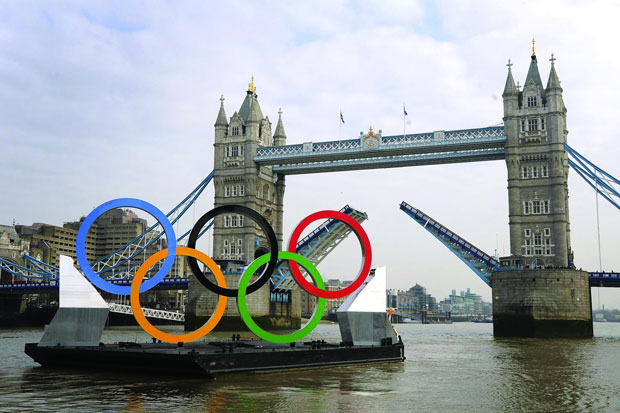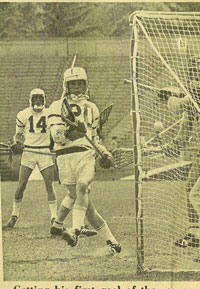Nearly 3,000 NBC employees are involved in the Olympics coverage. Gunts oversees an enormous team of researchers, sound engineers, lighting specialists, and producers, as well as a cadre of eighteen directors—half of them doing studio work and the rest located at venues focusing on specific sports like gymnastics, tennis, and beach volleyball. “It’s a massive undertaking,” says Rob Landau ’91, JD ’94, senior vice president at NBC Sports Group, who oversees all human resources, labor, and employment matters, including much of the planning for each Olympics. “The Games are a huge financial and time commitment for NBC and Comcast, and Bucky has been one of the key people responsible for turning it all into a production that we can be proud of.”
And by all accounts, Gunts isn’t just good at his job; he’s also pleasant to work with. In a high-pressure environment in which strong personalities work at a frenetic pace, he has a reputation for staying calm amid the storm. “He has a personality that I don’t think I’ve ever seen in the control room, in that he has a wonderful sense of humor that endears him to people,” his longtime boss, former NBC Sports chairman Dick Ebersol, once told the Baltimore Sun. “He gets more out of a crew than almost any director I’ve ever seen.” Gunts simply shrugs. “Everybody knows it’s serious, but it helps if you can keep it fun during those long days,” he says. “It’s not everyone’s approach, but it works for me.”
'There have been games where I wasn’t sure who won afterward. You get so caught up in what you’re doing that you might not know the final score.'Gervais might be disappointed to discover that Bucky Gunts wasn’t always Bucky Gunts; he was Brent Gunts Jr. (He was given his nickname as a child to distinguish him from his father.) His mother, Eleanor, was a fashion editor. His father was involved in the production of some fifty television shows in their native Baltimore over the course of several decades. As general manager at WBAL-TV for fourteen years, Brent Sr. made racial harmony a cornerstone of his tenure, scheduling numerous programs and interviews about the subject and pioneering the hiring of minorities. But one hire was nepotistic. Newly graduated from Cornell, Bucky Gunts earned $90 a week as WBAL’s overnight operational director. By 1979 he was working at WNBC in New York City. One of his colleagues there was Hall of Fame sportscaster Marv Albert, whose recommendation in 1983 earned Gunts a job as a director for NBC Sports. Except for a four-year stint directing the “Today” show (Gunts enjoyed the high-profile job, but not the hours), he has been there ever since.
Gunts describes directing TV coverage of a sporting event—and he has done it for Major League Baseball, the NFL, the NBA, and the PGA Tour—as a combination of extensive preparation and instinctive reaction. “I’ve always thought that being a Division I goalie was very good training for being a director,” says Gunts, who played on Cornell’s 1971 NCAA champion lacrosse team. “You have to see what’s going on in front of you, direct your team, tell them where to go. There’s the reaction time. All of these things come into play.”
It may seem counterintuitive, but Gunts says that a fast-paced sport like football or basketball can be easier to direct because it is essentially a matter of following the ball up and down the field or court. But baseball, for instance, can be difficult because it is less linear (hitters hitting, fielders fielding, runners running) and more unpredictable (as when a pitcher suddenly attempts a pickoff throw). And golf, languid as it may seem, is a challenge because the director has to be aware of eighteen holes’ worth of competitors and various on-course announcers. In fact, one simple golf swing (among hundreds shown in each round) requires a complex sequence of images: Start on a hand-held camera from behind the golfer, so the viewer can see the task ahead. Wait a beat after the swing, then cut to a shot of the ball in the air. Show it landing, then widen the shot to reveal its location relative to the hole. Finally, cut quickly back to the golfer’s reaction.
“Timing is everything in directing—timing and paying attention,” Gunts says. It’s more than just matching visuals to the announcers’ words. It begins with production meetings, where producers and analysts discuss plot points that may arise. “Storylines have become more and more involved,” he says, “so you have to be a lot more prepared going into the game.” Consider, for instance, a simple football scenario: an incomplete pass that just misses the fingertips of an intended receiver. The director may be aware that the receiver is recovering from a minor injury, which might lead to an instant replay showing him jumping gingerly. Or the director might instruct one of twenty camera operators to focus on the player’s injured knee. Or he could cut to a sideline shot of an athletic trainer. And all of that occurs in the few seconds before play resumes.
So within an event, the director is tasked with attending to every nuance. But ironically, sweating the small stuff occasionally means losing track of the big picture. “Actually, there have been games where I wasn’t sure who won afterward,” says Gunts, laughing. “You get so caught up in what you’re doing that you certainly might not know the final score.”

If directing a football game is a metaphorical sprint, then coordinating the broadcast of the Olympic Games constitutes marathon television. Gunts’s Olympic journey began in Seoul, South Korea, when he directed NBC’s late-night coverage of the 1988 Summer Games. He has directed the network’s primetime coverage since Barcelona in 1992 and every opening ceremony since the Salt Lake City Winter Games in 2002. Aside from overseeing last February’s Super Bowl pregame show, his focus for the past several years has been solely on Olympic preparation.

Gunts has already been to London a dozen times. He has taken his team of directors and producers to each Olympic venue, scouting everything from commentary locales for on-camera talent to camera positions (there may be twenty NBC cameras at the track and field stadium, for example, and more than a dozen covering gymnastics). They’re on the lookout for potential pitfalls, like the light that poured in from the open sides of the Georgia Tech Aquatic Center in 1996. It allowed a welcome breeze and offered a pretty view, but it was bad for TV. Gunts had to convince organizers to allow NBC to set up huge light-blocking scrims for the benefit of the television audience. “We have a lot of cumulative knowledge, but each of these Olympic committees gets the Games one time,” he says. “They’re all very aggressive. They want to do a good job, and they all do in the end—but they don’t have the basis for knowing what affects TV.”
Gunts has scouted locations for NBCUniversal’s four studios in London’s Olympic Park and has been intimately involved in the design of the parent network’s two primary London-based studios—one for NBC’s afternoon show and another for primetime and late night. He has consulted with designers on decisions both big (Which London icons will be projected behind Bob Costas?) and small (What books should be placed on background shelves?). But occasionally, the look of the studios is a product of happenstance. In 1996, Costas made use of a nifty desk that could rotate 360 degrees, providing different backgrounds. That necessitated a rotating ring of overhead lights, which were covered by a large cylinder—a practical afterthought. But over the years, Gunts has used the cylinder as a projection screen for graphics, and it is now an integral part of the design.


